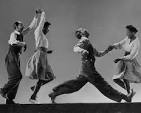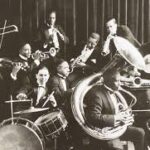
I recently traveling around the British Isles, so I thought I'd take a look at my favorite time period from an Irish perspective.
In the U.S., the Jazz Age is generally defined as the period from 1920 to the early 1930s in which jazz music and dance styles gained worldwide popularity.
The "Jazz Age" in Ireland is typically associated with the early 1930s, and coincided with the first decade of the "Irish Free State" (formed in 1922)—a period of political and social unrest for the country which had been under British rule for more than 800 years. In this fast-changing polysci climate, jazz disseminated its intoxicating music, dancing and lifestyle through the growing popularity of the gramophone  and wireless radio. Returning emigrants from America brought jazz records, music sheets and experienced of a free-spirited, rebellious style of behavior quite different from that of older Irish generations.
and wireless radio. Returning emigrants from America brought jazz records, music sheets and experienced of a free-spirited, rebellious style of behavior quite different from that of older Irish generations.
Novelist F. Scott Fitzgerald termed the 1920s "the Jazz Age." With its down-home rhythms, fast beat, and improvisational style, jazz symbolized the decade's spirit of liberation. At the same time, new dance styles arose, involving spontaneous bodily movements and closer physical contact between partners.
In the US, Jazz was controversial because it broke the rules – both musical and social. It featured improvisation over traditional structure, performer over composer, and black American experience over conventional white sensibilities. By the end of the 1920s, at least 60 municipalities had enacted laws prohibiting jazz in public dance halls. Nonetheless, jazz flourished under Prohibition, in gangster-run clubs and speakeasies — establishments that served alcohol and hired black musicians.
Jazz originated in African American communities, and its rise in popularity across all social strata sometimes fueling racial prejudices. Some white audiences viewed jazz as a threat to social norms and racial hierarchies, because it promoted black American experience over conventional white sensibilities.
The first years of the "Irish Free State," caused considerable debate over what it meant to be Irish. Music played a key role in Irish identity and culture and had traditionally been a fixture of Irish public and private life.
As the jazz craze became more entrenched, a distinction was made by many Irish people between jazz music and jazz dancing. While the  music may have been accepted, the proliferation of unlicensed all-night jazz dancehalls became a serious legal and moral issue. Members of older generations were both shocked and dismayed not only by the explosive tunes of a jazz band or gramophone record, but, worse, the sight of people feverishly danced the ‘black bottom’, ‘shimmy’, ‘Charleston’, ‘shag’ and ‘jitterbug’ rhythms that made their bodies jerk, convulse and lunge in uninhibited movements never before seen on an Irish dance floor.
music may have been accepted, the proliferation of unlicensed all-night jazz dancehalls became a serious legal and moral issue. Members of older generations were both shocked and dismayed not only by the explosive tunes of a jazz band or gramophone record, but, worse, the sight of people feverishly danced the ‘black bottom’, ‘shimmy’, ‘Charleston’, ‘shag’ and ‘jitterbug’ rhythms that made their bodies jerk, convulse and lunge in uninhibited movements never before seen on an Irish dance floor.
Jazz dance devotees struggled to explain to the uninitiated why it was so irresistible, sweeping them away in emotion. And that was exactly what Ireland's religious and moral guardians feared.
The Gaelic Athletic Association (GAA) even waded in, with some imposing a strict ban on any such dancing at their functions. At the annual convention, one GAA secretary argued: ‘A man who plays Gaelic football and goes to jazz dances – "foreign" dances – is the hallmark of shoneenism!’ [a pejorative term used to describe Irish people who are viewed as engaging in excessive Anglophilia or snobbery.] The secretary favored a complete ban on jazz dancing for all GAA members – who, being young and athletic, loved jazz in all forms.
The growing hysteria around jazz in the 1920s and 30s reached a climax in 1934, when on New Years’ Day, the Anti-Jazz Movement took to the streets of Limerick for a protest, an event at which the Finance Minister, Sean O’Ceallagh, was criticized by the speaker for “jazzing the soul of the nation away.”
Fun Fact: In the UK, the musicians' union effectively banned American jazz musicians from touring the country for about 20 years, from 1934 to 1956 —a ban that was partly motivated by a desire to protect British musicians' jobs.